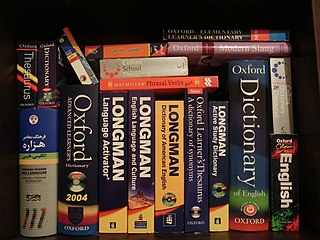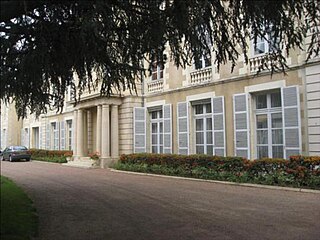Amharic is one of the Ethiopian Semitic languages, which are a subgrouping within the Semitic branch of the Afroasiatic languages. It is spoken as a first language by the Amharas and as a lingua franca by other populations residing in major cities and towns of Ethiopia. The language serves as the official working language of Ethiopia, and is also the official or working language of several of the states within the Ethiopian federal system. With 21,811,600 total speakers as of 2007, including around 4,000,000 L2 speakers, Amharic is the second-most commonly spoken Semitic language in the world, after Arabic.

Ethiopia is a federal state subdivided into ethno-linguistically based regional states and chartered cities. This system of administrative regions replaced the provinces of Ethiopia in 1992 under the Transitional Government of Ethiopia and was formalised in 1995 when the current Constitution of Ethiopia came into force.
Argobba is an Ethiopian Semitic language spoken in an area north-east of Addis Ababa by the Argobba people. It belongs to the South Ethiopian Semitic subgroup along with Amharic and Gurage languages. Writing in the mid-1960s, Edward Ullendorff noted that it "is disappearing rapidly in favour of Amharic, and only a few hundred elderly people are still able to speak it." Today, many Argobba in the Harari region are shifting to the Oromo language.
Jacques Feyder was a Belgian actor, screenwriter and film director who worked principally in France, but also in the USA, Britain and Germany. He was a leading director of silent films during the 1920s, and in the 1930s he became associated with the style of poetic realism in French cinema. He adopted French nationality in 1928.
Prof. Olga Kapeliuk is an Israeli linguist.
Siltʼe is an Afroasiatic language spoken in central Ethiopia. One of the Ethiopian Semitic languages, its speakers are the Siltʼe, who mainly inhabit the Silte Zone in the Southern Nations, Nationalities, and People's Region. Speakers of the Wolane dialect mainly inhabit the Kokir Gedebano district of Gurage Zone, as well as the neighbouring Seden Sodo district of Oromia. Some have also settled in urban areas in other parts of the country, especially Addis Ababa.

Afäwarq Gäbrä Iyäsus was an Ethiopian writer, who wrote the first novel in Amharic, Ləbb Wälläd Tarik, . Bahru Zewde writes, "Few people before or after him have demonstrated such superb mastery of the Amharic language. Few have ventured with such ingenuity into the hidden recesses of that language to come out with a wealth of vocabulary and idiom one scarcely thought the language possessed. Afäwarq is nonetheless a controversial figure for having supported the Italians during both the First and Second Italo-Abyssinian Wars.

Blattengeta Heruy Welde Sellase was a Foreign Minister of Ethiopia and a writer in Amharic. Bahru Zewde observes that his career "stands out as the great success story ... of the early twentieth-century intellectuals," then continues, "His prolific literary record, his influence with Tafari-Hayla-Sellase and his ascent in the bureaucratic hierarchy were all characterized by an unchequered progression. Edward Ullendorff concurs in this evaluation, describing his oeuvre as "a considerable and distinguished literary output."

The Roman Catholic Diocese of Laval is a Roman Catholic Latin Rite diocese in France. The episcopal see is Laval Cathedral in the city of Laval. Created in June 1855, the diocese was originally erected from the Diocese of Le Mans, and corresponds to the department of Mayenne. Under the Ancien Régime the diocese of Mans had an Archdeacon of Laval, whose responsibilities extended over the deaneries of Ernée, Évrun, Laval and Mayenne. The diocese is a suffragan of the Archdiocese of Rennes, Dol, and Saint-Malo.
Marcel Samuel Raphaël Cohen was a French linguist. He was an important scholar of Semitic languages and especially of Ethiopian languages. He studied the French language and contributed much to general linguistics.

The Ethio-Djibouti Railway (French: Chemin de Fer Djibouto-Éthiopien is a metre gauge railway in the Horn of Africa that once connected Addis Ababa to the port city of Djibouti. The operating company was also known as the Ethio-Djibouti Railways. The railway was built in 1894–1917 to connect the Ethiopian capital city to the then-French colony of Djibouti. During early operations, it provided landlocked Ethiopia with its only access to the sea. After World War II, the railway progressively fell into a state of disrepair due to competition from road transport.
Father Émile-Fortuné Petitot, a French Missionary Oblate, was a notable Canadian northwest cartographer, ethnologist, geographer, linguist, and writer.
Caressa & Français was a distinguished firm in Paris that specialized in fine musical instruments and bows.
Séraphin Couvreur was a French Jesuit missionary to China, sinologist, and creator of the EFEO Chinese transcription. The system devised by Couvreur of the École française d'Extrême-Orient was used in most of the French-speaking world to transliterate Chinese until the middle of the 20th century, after what it was gradually replaced by pinyin.

This is a survey of the postage stamps and postal history of Ethiopia. Long an independent state in Africa, messages were originally carried by couriers called méléktegnas, who held the letters attached to a stick.
Jean-François Cars, was a French engraver, printer, publisher and printseller from Lyon.

Mersha Nahusenay was a reformist and pioneer of change who made important contributions to the modernization and independence of Ethiopia. One of the closest advisors to Emperor Menelik II, he went on to become the founder and first governor of Dire Dawa, the second largest city in Ethiopia, and its environs (1902–1905). Prior to that he was governor of the strategic and frontier district of Jaldessa (Gildessa) where he also held the position of head of customs. His public career lasted over three decades from the era of Menelik II until the reign of Haile Selassie. He was one of the most recognized Ethiopians of his time. He knew the French language and was open to European ideas and way of life earning him admiration abroad. His most enduring legacy was the construction, maintenance and security of the first railway which he oversaw at the request of Menilek. Mersha belongs to a generation who took advantage of the relative stability of the late 19th – early 20th century to implement a series of wide-ranging political, economic and social reforms which put the country on the path to modernization ushering in a new era.

Jean-Baptiste-Antoine Guillemet was a French renowned landscape painter and longtime Jury member of the Salon des Artistes Francais. He was one of the first 19th-century artists to paint modern life, and a pivotal figure in the transition from Realism to Impressionism.
Joseph Pierre de Bonnecamps was a French Jesuit, missionary, priest and professor and tutor.















